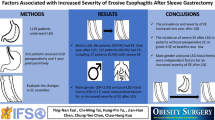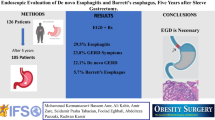Abstract
Background
Erosive esophagitis (EE) is related to esophageal mucosal damage caused by GERD and is implicated in the development of Barret´s esophagus and adenocarcinoma, which incidence is rising in association with obesity. It is known that the correlation between symptoms and endoscopic findings is relatively poor, with a predictive value of only 40%. The objective of this study is to report the incidence of EE 1 year after sleeve gastrectomy (SG) and gastric bypass (GBP) in consecutive patients in order to obtain an objective parameter of the impact of the two most popular bariatric procedures on esophageal mucosa.
Methods
A retrospective review of a prospective database including every primary GBP and SG consecutive cases performed between January 2014 and December 2016. Esophagitis evolution was compared between patients with adequate weight loss versus those with inadequate weight loss. The comparison of baseline and 1-year EE, BMI, %EWL, and %TWL was made by using the Chi square test for categorical variables and Student “t” test for continuous samples.
Results
Two hundred and twenty-seven patients were included. GBP was performed to 35.2% (n = 80) and SG to 64.8% (n = 147). Pre- and postoperatively EE evolution in GBP decreased from 54 to 26.2% (p = 0.002) and in SG increased from 8.2 to 30% (p = 0.04) Barret´s esophagus in GBP decreased from 7.5 to 5% (p = 0.001). No statistical difference was observed when we compared the evolution of EE in patients with adequate or inadequate weight loss in both groups.
Conclusions
The incidence of EE 1 year after SG is greater than GBP. Moreover, not only GBP seems to improve this condition, but also SG tends to worsen EE. These results are to be associated with GERD disease.



Similar content being viewed by others
References
Hendricks L, Alvarenga E, Dhanabalsamy N, Lo Menzo E, Szomstein S, Rosenthal R (2016) Impact of sleeve gastrectomy on gastroesophageal reflux disease in a morbidly obese population undergoing bariatric surgery. Surg Obes Relat Dis. https://doi.org/10.1016/j.soard.2015.08.507
Andrew B, Alley JB, Aguilar CE, Fanelli RD (2017) Barrett’s esophagus before and after Roux-en-Y gastric bypass for severe obesity. Surg Endosc. https://doi.org/10.1007/s00464-017-5768-6
Wang KK, Sampliner RE (2008) Updated guidelines 2008 for the diagnosis, surveillance and therapy of Barrett’s esophagus. Am J Gastroenterol. https://doi.org/10.1111/j.1572-0241.2008.01835.x
Gorodner V, Viscido G, Signorini F, Obeide L, Moser F (2018) Gastroesophageal reflux disease and morbid obesity: evaluation and treatment. Updates Surg. https://doi.org/10.1007/s13304-018-0579-4
Huang CS, Forse RA, Jacobson BC, Farraye FA (2003) Endoscopic findings and their clinical correlations in patients with symptoms after gastric bypass surgery. Gastrointest Endosc. https://doi.org/10.1016/S0016-5107(03)02310-1
Sapala JA, Wood MH, Sapala MA, Flake TM (1998) Marginal ulcer after gastric bypass: a prospective 3-year study of 173 patients. Obes Surg. https://doi.org/10.1381/096089298765554061
Chan K, Liu G, Miller L et al (2010) Lack of correlation between a self-administered subjective GERD questionnaire and pathologic GERD diagnosed by 24-h esophageal pH monitoring. J Gastrointest Surg. https://doi.org/10.1007/s11605-009-1137-7
Spinosa SR, Valezi AC (2013) Endoscopic findings of asymptomatic patients one year after roux-en-y gastric bypass for treatment of obesity. Obes Surg. https://doi.org/10.1007/s11695-013-0936-9
NIH (1992) Gastrointestinal surgery for severe obesity: National Institutes of Health Consensus Development Conference Statement. Am J Clin Nutr. https://doi.org/10.1093/ajcn/55.2.615s
Lundell LR, Dent J, Bennett JR et al (1999) Endoscopic assessment of oesophagitis: clinical and functional correlates and further validation of the Los Angeles classification. Gut. https://doi.org/10.1136/gut.45.2.172
Braghetto I, Korn O, Csendes A, Gutiérrez L, Valladares H, Chacon M (2012) Laparoscopic treatment of obese patients with gastroesophageal reflux disease and Barrett’s esophagus: a prospective study. Obes Surg. https://doi.org/10.1007/s11695-011-0531-x
Herbella FAM, Sweet MP, Tedesco P, Nipomnick I, Patti MG (2007) Gastroesophageal reflux disease and obesity. Pathophysiology and implications for treatment. J Gastrointest Surg. https://doi.org/10.1007/s11605-007-0097-z
El-Hadi M, Birch DW, Gill RS, Karmali S (2014) The effect of bariatric surgery on gastroesophageal reflux disease. Can J Surg. https://doi.org/10.1503/cjs.030612
Madalosso CAS, Gurski RR, Callegari-Jacques SM, Navarini D, Mazzini G, Pereira MDS (2015) The impact of gastric bypass on gastroesophageal reflux disease in morbidly obese patients. Ann Surg. https://doi.org/10.1097/sla.0000000000001139
Tai CM, Huang CK, Lee YC, Chang CY, Lee CT, Lin JT (2013) Increase in gastroesophageal reflux disease symptoms and erosive esophagitis 1 year after laparoscopic sleeve gastrectomy among obese adults. Surg Endosc. https://doi.org/10.1007/s00464-012-2593-9
Viscido G, Gorodner V, Signorini F, Navarro L, Obeide L, Moser F (2018) Laparoscopic sleeve gastrectomy: endoscopic findings and gastroesophageal reflux symptoms at 18-month follow-up. J Laparoendosc Adv Surg Tech. https://doi.org/10.1089/lap.2017.0398
Gorodner V, Viscido G, Signorini F, Obeide L, Moser F (2018) Gastroesophageal reflux disease and morbid obesity: evaluation and treatment. Updates Surg. https://doi.org/10.1007/s13304-018-0579-4
Melissas J, Braghetto I, Molina JC et al (2015) Gastroesophageal reflux disease and sleeve gastrectomy. Obes Surg. https://doi.org/10.1007/s11695-015-1906-1
Genco A, Soricelli E, Casella G et al (2017) Gastroesophageal reflux disease and Barrett’s esophagus after laparoscopic sleeve gastrectomy: a possible, underestimated long-term complication. Surg Obes Relat Dis. https://doi.org/10.1016/j.soard.2016.11.029
Csendes A, Smok G, Burgos AM (2012) Prospective Sequential Endoscopic and histologic studies of the gastric pouch in 130 morbidly obese patients submitted to roux-en-y gastric bypass. ABCD Arq Bras Cir Dig. https://doi.org/10.1590/S0102-67202012000400007
Houghton SG, Romero Y, Sarr MG (2008) Effect of Roux-en-Y gastric bypass in obese patients with Barrett’s esophagus: attempts to eliminate duodenogastric reflux. Surg Obes Relat Dis. https://doi.org/10.1016/j.soard.2007.10.003
Gorodner V, Buxhoeveden R, Clemente G, Sánchez C, Caro L, Grigaites A (2017) Barrett’s esophagus after Roux-en-Y gastric bypass: does regression occur? Surg Endosc. https://doi.org/10.1007/s00464-016-5184-3
Rosenthal RJ, International Sleeve Gastrectomy Expert Panel, Diaz AA et al (2012) International sleeve gastrectomy expert panel consensus statement: best practice guidelines based on experience of >12,000 cases. Surg Obes Relat Dis. https://doi.org/10.1016/j.soard.2011.10.019
Melissas J, Koukouraki S, Askoxylakis J et al (2007) Sleeve gastrectomy—a restrictive procedure? Obes Surg. https://doi.org/10.1007/s11695-007-9006-5
Author information
Authors and Affiliations
Corresponding author
Ethics declarations
Disclosures
Franco Signorini, Santiago Olguín, Germán Viscido, Lucio Obeide, and Federico Moser declare that they have no conflicts of interest or financial ties to disclose.
Additional information
Publisher's Note
Springer Nature remains neutral with regard to jurisdictional claims in published maps and institutional affiliations.
Rights and permissions
About this article
Cite this article
Signorini, F., Olguín, S., Viscido, G. et al. Esophagitis evolution after sleeve gastrectomy or gastric bypass in consecutive cases. Surg Endosc 34, 4330–4335 (2020). https://doi.org/10.1007/s00464-019-07199-7
Received:
Accepted:
Published:
Issue Date:
DOI: https://doi.org/10.1007/s00464-019-07199-7




